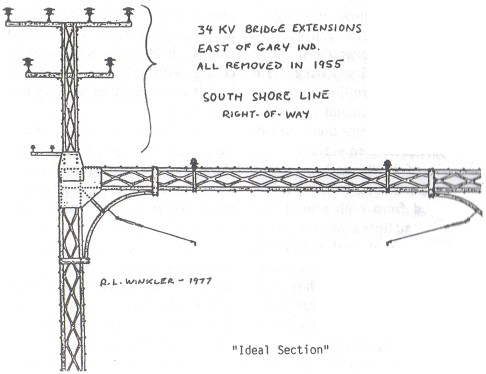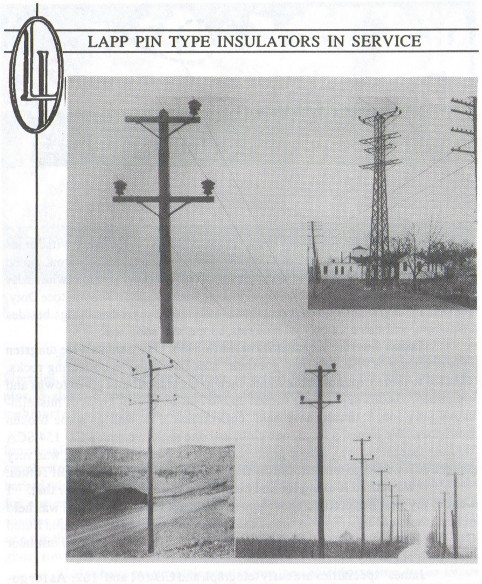"Insulatoring" From the beginning to the First National (Condensed Version)
by Robert L. Winkler
Reprinted from "Crown Jewels of the Wire", May 1994, page 3
25 Years of Collecting
The following story is all true, it may not be very good, but it IS TRUE!
I was born in East Chicago, Indiana, on September 3rd, 1951, a day that will
live in "Infamy"! By the end of 1953 or early 1954, I'd already
noticed power lines and insulators. I vividly recall the old 34KV steel power
line supports on top of the old South Shore Line interurban railway catenary
support bridges, at Miller Indiana, east of Gary. These extensions were removed
in the summer of 1955.
I began picking up insulators about 1956. My first
"find" was a broken two piece "Victor" Locke M-2810 found
along the South Shore right-of-way behind my grandparents home near Michigan
City, Indiana. My grandfather carried it home as I was too young to lug it back!
Until the late 1950s, my term for insulators was "cups"! Well, at age 4 or 5, you have to call
them something simple!
It was during the earliest formative years of my misspent
youth that I had my first "real life" experience with the utility
industry. I could walk the few blocks from home to school at Harding Elementary
in the Hammond suburb of Hessville. One day, as I was heading home, a utility
line crew was working on the distribution lines near my school on my route home.
What luck! Rather gingerly I approached a lineman and politely inquired about
obtaining some insulators.
I can't recall the exact words of his reply, but in
plain, frank clear angry English, I was told to scram!!
I took off for home as
fast as a first grader can and did not look back to see if I was followed! This
was shortly before the advent of Jet Liners and my "Rocket 'Propelled"
retreat home made for quite an impression on the suburban neighborhood! An
estimated crowd of several thousand came to see the skid marks where I braked for my landing
at home!
It was two or three years before I approached a line crew about
insulators again! Happily, I got the worst of it over early. From then on my
encounters with utility employees were much more cordial and enjoyable, if not
always a success insulator-wise.
Soon, I was dragging home crossarms, pins, hardware, etc. I began making crude pole line sketches about this time too. In
1958 or 1959 I found a Continental Rubber Company R-3 unit along, the old Nickle
Plate Road Line near our home in the suburban Hammond, Indiana area. What a find
it was! !
My Dad worked at Inland Steel at the time and one day brought home two
insulators he found along the railroad line at the plant entrance. They were a
dull blackish grey with a shiny pin hole and were marked Hemingray-42. It was
months later that I accidentally chipped one and then I saw it! Blue glass! They
were so filthy, I didn't even realize they were glass until I chipped that drip
point!!
From 1960 to 1968, I picked up what insulators I came across and
continued to draw pole lines and collect hardware. In 1962, we moved out to
Michigan City where I first met Paul Mohrs. After a few years of watching my
collecting he entered the hobby and became a very active collector from about 1969 until about 1982. He lived near the old
Michigan Central right-of-way. While playing around one day, we crossed the
tracks. It was then I noticed all the glass insulators around the base of an old
line pole. I didn't understand then in 1963, but I was standing on some real
early classic telegraph glass! CD 126s, American Base Embossed beehives, CD 133
1865 Cauvet's, etc., littered the ground around every pole! I picked up several
bags full and dragged them home. Some actually survived the ordeal!
I maintained
an interest in glass and porcelain, communication and power, from the beginning.
About 1967 or 1968, I got a real "shock", no pun intended! A local
antique dealer told my mother, after she mentioned my "strange" hobby
(or affliction) that it was not so strange! In fact she had insulators for sale
in her antique shop! I finally got to her shop and indeed, she had more
different insulators than I'd yet seen. Also, she had books on the subject. I
soon ordered these books (by John C. Tibbits) and in 1968, real collecting
began in earnest!
Late in 1969, my antique dealer introduced me to a
"big" collector/dealer of the new hobby, He was Rodney Wing, of
Detroit, Michigan. He came down to my house and told me about all the different
insulators he knew of. Most importantly, he told me of a new collector's magazine, just out a few months, called "Crown Jewels of the
Wire", which he said I should subscribe to. Shortly after this time I was
receiving this great magazine. At the end of our session, Rodney gave me a near
mint Pyrex carnival CD 326! Talk about frosting on the cake!! He also mentioned
talk of a national gathering of insulator collectors being proposed in the near
future.
And so it was that June of 1970, the First National Insulator Show was
held at New Castle, Indiana, less than 200 miles from my home! After months of
anticipation, the day arrived and my mother, father and I were on the road to
New Castle. The trip itself was an "experience" of never before seen
utility companies, line construction designs and of course, insulators.
The show
can't really be described! It was overwhelming to me! I saw my first Locke
"rain gutter", B&O's (in lime green, no less) and porcelain and
glass "galore" and some items that it's said, have not been seen
since!!
One of the things I remember best is the trading I did. I'd just
graduated from high school that June and had little cash. What I did have was
about twelve CD 145 H.G. Co., deep jade green beehives, that looked as if they
were made of wax! Paul Mohrs and I had picked these out of the briars and muck
along the old Lakeshore & Michigan Southern Railway near
LaPorte, Indiana.
To my total surprise, these traded like hot cakes! The best
item I recall getting, and which I had until about 1985, was a CD 102 45 Cliff
Street Brookfield in a beautiful yellow green, which is why I'd like to find
another, or that one!
The beautiful orange and red amber H.G. Co. and Hemingray
CD 162s someone had set in a window so the light could stream through must have
left an impression. I still remember them!
I met the Harned's of Crown Jewel
magazine fame and traded for a nice "smoke grey" CD 160 California
from them. I did not know him then, but I also met one of the early classic
porcelain buffs of this area, Dave Ramp, of Columbia City, Indiana. Also our
great mustached leader of the original Columbia City show fame, Paul Houpt. Rod
Wing was there, of course, with "table loads" of goodies. It was a day
that went by fast -- too fast!
I will close the First National saga with my
"insulator of the show" tale. The most interesting thing about it is
that the insulator, or more correctly, insulators, were not actually at the
show!
On the way down, and back, along a nice rural stretch of old two lane
Highway 38, I came across an old 66 KV line of the Public Service Company of
Indiana. The line had originally been constructed in the 1920s by a
predecessor utility
called Indiana Electric Corporation. The construction was a bit odd from that
of the newer PSI lines I'd seen which were equipped with 66 KV tie-top Line
Posts. This line was all on three piece pintypes. I knew they were mostly, if
not all Lapps, simply by the colors. Some were a dark red brown, ordinary
enough, but others, wow! Brilliant orange tops, red middles, orange bottoms, red
tops, orange middles, red bottoms, and every combination in between! Some were
entirely bright orange. What a sight to someone raised on chocolate Ohio
Brasses! In 1976, I returned with Dave Ramp to this area to get a few pictures
of this line. GONE!!!! Not even a pole stump left to tell where it had been!

Like the First National Show itself, it was a "one time" experience
I was privileged to witness. I'm glad that I had the opportunity for both. I'd
never have seen that line if not for the show. The First National was indeed a
memorable experience for me and remains so to this day.
Looking back with a
historical perspective, it was the establishment of Crown Jewels magazine in
1969 and the First National of 1970, that formed the watershed events which
established the collecting of insulators as an "active hobby" that
will continue to live as long as the magazine and shows are around to maintain
older enthusiasts enjoyment and to attract new advocates.
|

Main Photograph -- Lapp No. 6173 on line of Indiana Electric Corporation
operating at 66 KV. Installed 1923.
Upper Insert -- Lapp No. 6396 Fog Type insulators on line of Kansas Utilities
Company, Fort Scott, Kansas.
Lower Insert -- Lapp Fog Type No. 5842 on 33 KV. line of Panhandle Power and
Light Company, Borger, Texas. Nielsen Survey No. LP-65-JA describes in detail
the unusual performance record of these units as compared with standard type
insulators.
|
At the 1993 London,
Ohio show, I finally obtained a copy of the 1931 Lapp
catalog from Ken Stefan. After almost 25 years, I now have a photo (Main
Photograph above) of the I.E. Corporation construction just as I recalled it
along Hwy. 38!!!
|
